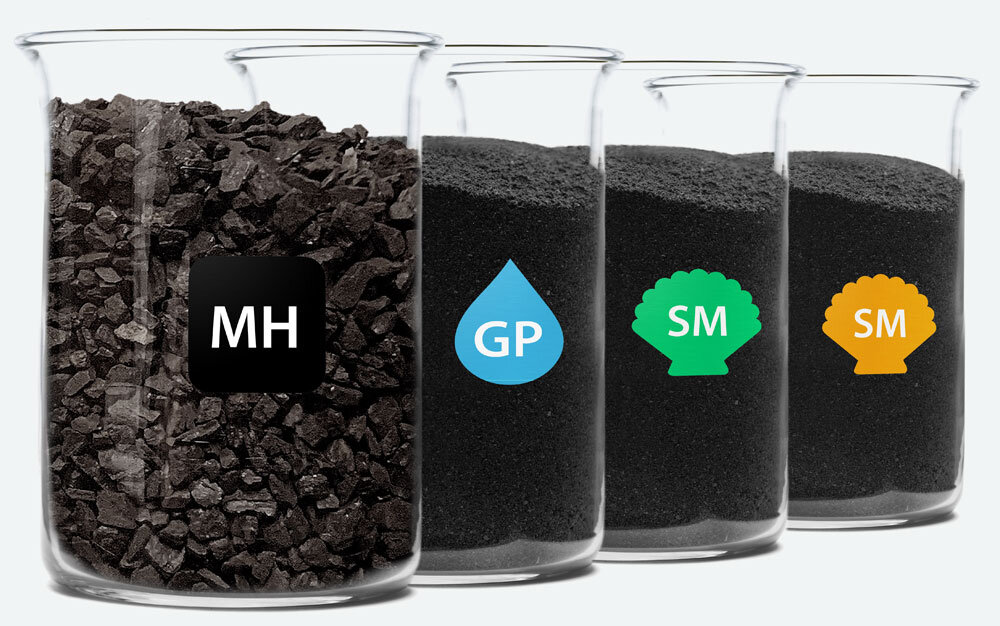Humic Acid: A Glossary of Related Terms
The science of humic acid is surrounded by terminology that can become confusing. Here’s an annotated list of terms that are most often referenced.
Biostimulant
A biostimulant is defined (in Europe) as any substance or microorganism that is applied to plants to stimulate natural processes, with the goal of improving nutrient uptake, nutrient efficiency, resistance to stress, and crop quality. There is not currently an agreed upon definition in the United States. Biostimulants can be applied as early as the germination stage, and they are often applied throughout a crop’s life cycle. Examples of biostimulants include humic and fulvic acids, beneficial microorganisms (fungi and bacteria), seaweed extracts, proteins, enzymes, and other organic acids. Biostimulants operate via different mechanisms than fertilizers, and work well in tandem with them to ensure optimal nutrient uptake by plants.
Carbon
Carbon is fundamental to all life on Earth. When it comes to soil science, there are four primary categories of carbon: elemental carbon, soil inorganic carbon, soil organic carbon, and soil organic matter. Elemental carbon’s four unpaired electrons in its outer shell makes it very useful for forming complex chains of molecules, which is vital for the formation of life. Soil inorganic carbon refers to carbon which has been extracted from ores, and which is not readily available for uptake by organisms. Soil organic carbon, on the other hand, is a key food source for life in the soil. This type of carbon results from the decomposition of plants and animals. Soil organic matter is a “catch-all” term that includes all of the decaying plant and animal material in a given soil.
Cations
Cations (pronounced “cat-eye-on”) are ions with a net positive charge (as opposed to anions, which carry a negative charge). In soil science, cations often refer to positively charged nutrients (such as potassium, magnesium, calcium) which plants require for good health. “Cation exchange capacity,” or CEC, refers to a given’s soil ability to hold onto these positively charged ions. Because humic acids have a net negative charge and bind easily to beneficial cations, they help improve the cation exchange capacity of the soil, which improves nutrient uptake by plants.
Chelation
The word “chelate” comes from the Greek word for claw, and that’s a useful metaphor for chelation. Chelation is the process by which a substance is used to bind molecules, such as minerals and metals. In soil, humic acids are excellent chelators, meaning they bind to beneficial nutrients and make them more readily available to plants. Humic acids also bind well to toxic metals, which the plant roots then don’t absorb. This version of chelation is referred to as “buffering.” So, as a chelating agent, humic acids both increase the availability of nutrients, and prevent the unwanted uptake of toxic materials.
Compaction
Compaction is a form of soil degradation whereby the soil particles become highly compressed, which reduces the amount of space available for air, water, and organic matter. This effect can impede root growth and prevent the healthy exchange of nutrients in the soil. Modern farming methods (such as heavy tilling equipment) can cause compaction over time, which can lead to further challenges and a stark decrease in crop yield. Humic acid, when applied to soil, has shown the capacity to reverse compaction over time.
Compost
Compost is fresh, decomposing organic matter. It provides a rich food source for soil microorganisms, which in turn improve overall soil health. However, compost is not the same thing as humus. Compost contains some humus, but compost is generally much younger than humus, which is itself much older and is resistant to further decay. So implementing compost as a source of humus would not be the most beneficial route to take. Rather, compost should be used primarily as a “food source” for the soil, whereas fertilizer is a food source for the plant. And humus is best sourced from older, richer sources—referred to as humates—which formed over thousands or millions of years.
Fertilizer
A fertilizer is any material that is added to soil or plants as a nutrient. Strictly speaking, humic acids are not fertilizers. Rather, they are often referred to as soil amendments, or more recently as biostimulants, because of their ability to improve water retention, nutrient absorption, soil structure, and much more. (For the benefits of humic acid, please view our full-length article here.)
Fulvic Acid
Fulvic acids are much smaller molecules than humic acids, ranging in molecular size from 1,000 to 10,000. They're soluble in water at all pH levels, unlike humic acids, which are only soluble in alkaline solutions. There are two types of fulvic acids–fulvates, which are molecules bound to minerals, and free-form fulvic acids. Fulvic acids consist mostly of carbon, hydrogen, oxygen, and nitrogen. Like humic acids, they're formed through microbial decay. They are golden in color and are more biologically active than humic acids, due to an oxygen content that is nearly twice that of humic acids. The principal benefit of fulvic acids is their ability to bind to nutrients and transfer those nutrients into plants. For more information about fulvic acids, visit our comparison of humic and fulvic acids here.
Humate
Humate refers to black solid matter, typically freshwater in origin, that originates from lignite or sub-bituminous material. Humates have been oxidized near a surface, which results in a material rich in humic acid. Thus, humate is nature’s densest source of humic acid, which makes it a vital source of these acids for modern agriculture. Currently, humates can not be produced synthetically. Instead, humates form from ancient wetland environments. Over time, these massive beds of decaying material were covered by heavy formations, where they compress under intense pressure.
Humic Acid
Humic acids are fully decomposed remains of organic life. They're long-chain molecules that are high in weight and dark brown in color. They are not a single acid. Rather, "humic acid" is a broad term that refers to a complex mixture of many different acids that are soluble in alkaline solutions. They exist naturally as part of nature's life cycle in soils, oceans, and streams. For more information about humic acids, visit our in-depth article here.
Humin
Humin is one of the three constituents of humus (along with humic and fulvic acids). Humin complexes are the largest in molecular size of the three components of humus. However, to date they have not proven highly productive for agricultural use, largely because they are not soluble at any pH, and have a tendency to clog equipment. They also take a very long time to break down in soil, sometimes decades. At Earthgreen, we use a spray-drying process to remove humin from our water soluble products, which improves our products’ ease of use for growers.
Humus
Humus refers to the fraction of soil organic matter that is resistant to further decomposition. Although “humus” is sometimes loosely used to describe products such as compost, there is a distinction between the two. Humus does not resemble plant material, while compost is fresher material that includes substances which are still identifiable as plant remains. Put another way, humus is what results after compost has been ingested and excreted by soil life over a significant period of time, and has resulted in stable molecular compounds which are resistant to further decomposition. Compost feeds the soil, while humus provides other benefits, such as increased water and nutrient retention.
Leonardite
Leonardite is a term used to describe lignite that has been oxidized, and is typically mined near the surface for use as a soil amendment. Humate and leonardite are sometimes used interchangeably, though humate oftentimes refers to oxidized sub-bituminous material. Further, leonardite tends to refer to a saltwater source, specifically in North Dakota, whereas humates tend to be freshwater in origin. There are not official designations between the two, nor are there specified levels of humic acid which would qualify a material as leonardite or humate. (However, if the material contains none or very little humic acid, it’s not leonardite.)
Menefee Formation
The Menefee Formation is located in northwest New Mexico (and southwest Colorado), in what is known as the San Juan Basin. Within the Earth’s crust, the Menefee Formation is located inside what is known as the Mesaverde Group (previously known as the Mesaverde Formation). This group includes the Cliff House Sandstone above, and the Point Lookout Sandstone below the Menefee formation. The formation has an average thickness of 350-400 feet. The Menefee Formation is up to 2,000 feet thick in the Southern San Juan Basin. In other parts, it is only 50-100 feet thick. The altitude of the Menefee Formation ranges from about 5000-7000 feet above sea level. It developed between 75-100 million years ago, in the late Cretaceous period. This period was one of the earth’s most vibrant in history, boasting an amazing variety of life. The period ended with a Great Extinction, brought by a meteor that struck the earth and eradicated most dinosaur species. Earthgreen’s products are all derived from this formation.
Molecular Weight
Molecular weight refers to the weight of all atoms in a given molecule. This weight is measured in Atomic Mass Units. As it relates to humus, the molecular weight of fulvic acids are the smallest, followed by heavier humic acids. Humin (which is insoluble at an pH) carries the largest molecular weight, on average.
Peat
Peat is an accumulation of decaying organic matter which is sourced from peatlands or bogs. Peat differs from compost, as it must be harvested from specific locations and transported, whereas compost is derived from a variety of sources. Peat tends to be expensive and requires much energy and time to produce.
Soil Composition
Soils are composed of these four principal components: minerals, air, water, and organic matter. Roughly 45% of soil is made up of minerals, which include sand, silt, and clay. About 25% of soil is air, and another 25% is typically water. The remaining 5% of soils are composed of organic matter (detailed below). The six primary classifications of soil are: chalky, clay, peaty, silty, sandy, and loamy.
Soil Organic Matter
Although only 5% of soil is typically made up of organic matter, this material is the “life” of the soil that largely dictates its health. Of that 5%, the organic matter generally consists of 10% fresh organic residue, 30-50% active fraction organic matter, 30-50% stabilized organic matter (humus), and about 5% living organisms, such as bacteria, fungi, and earthworms. Earthgreen’s products restore the stabilized organic matter that is missing from much of today’s farmland.
Sustainable Agriculture
The goal of sustainable agriculture is to meet the world’s food needs today without depleting the Earth’s resources and compromising future generations. This includes efforts to use less water, less fertilizer, fewer synthetic chemicals and pesticides, and less energy to produce crops. At Earthgreen, we pride ourselves in contributing to this effort. All of our products help to achieve each goal laid out above. By adding our products to a grower’s fertility program, water retention is improved, fertilizers are more efficient, fewer pesticides are needed, and less work is required to generate high crop volume and health.
Ready for results?
Get 10% off your first order of our premium humic acid products.


